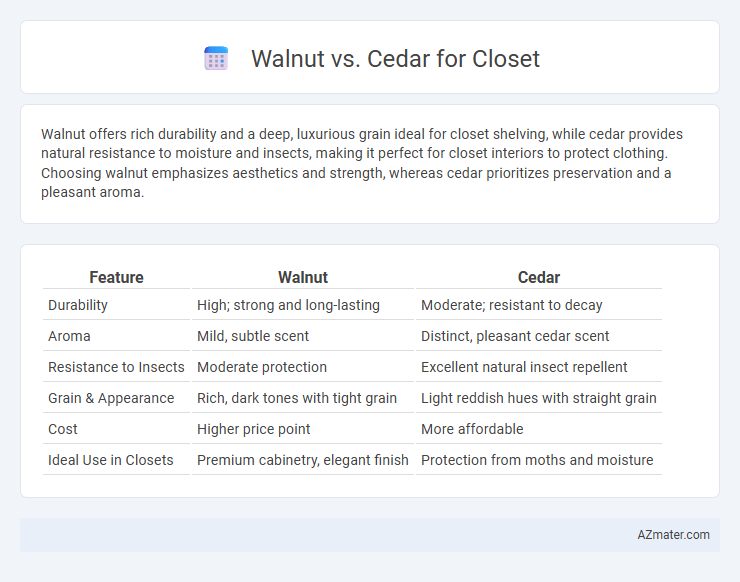Walnut offers rich durability and a deep, luxurious grain ideal for closet shelving, while cedar provides natural resistance to moisture and insects, making it perfect for closet interiors to protect clothing. Choosing walnut emphasizes aesthetics and strength, whereas cedar prioritizes preservation and a pleasant aroma.
Table of Comparison
| Feature | Walnut | Cedar |
|---|---|---|
| Durability | High; strong and long-lasting | Moderate; resistant to decay |
| Aroma | Mild, subtle scent | Distinct, pleasant cedar scent |
| Resistance to Insects | Moderate protection | Excellent natural insect repellent |
| Grain & Appearance | Rich, dark tones with tight grain | Light reddish hues with straight grain |
| Cost | Higher price point | More affordable |
| Ideal Use in Closets | Premium cabinetry, elegant finish | Protection from moths and moisture |
Introduction: Why Choose the Right Wood for Closets?
Choosing the right wood for closets directly impacts durability, fragrance, and resistance to pests. Walnut offers a rich, dark finish with natural strength, while cedar provides exceptional aromatic properties and natural insect repellency. Selecting between walnut and cedar balances aesthetics with functional benefits crucial for closet longevity and garment preservation.
Overview of Walnut and Cedar Woods
Walnut wood is a dense, durable hardwood valued for its rich, dark brown color and fine, straight grain, making it a popular choice for high-end closet cabinetry and furniture. Cedar wood is a lightweight, aromatic softwood known for its natural resistance to moisture, insects, and decay, which helps protect clothing and stored items from damage. Both woods offer unique benefits: walnut provides strength and elegance, while cedar offers protective qualities and a distinctive scent ideal for closet environments.
Walnut Wood: Key Characteristics and Benefits
Walnut wood offers rich, dark tones and a smooth grain pattern that enhances the aesthetic appeal of closet interiors, making it a luxurious choice. Its durability and resistance to warping ensure long-lasting structural integrity, ideal for closet shelves and doors undergoing frequent use. Walnut also ages gracefully, developing a unique patina that increases both its beauty and value over time.
Cedar Wood: Key Characteristics and Benefits
Cedar wood is renowned for its natural aromatic properties and resistance to moths, making it an ideal choice for closet lining and storage. Its fine grain and reddish hue provide an attractive, durable finish that also helps regulate humidity, protecting clothing from moisture damage and mildew. Compared to walnut, cedar offers superior insect repellency and moisture control, enhancing garment preservation.
Durability Comparison: Walnut vs Cedar
Walnut offers strong durability with its dense grain and resistance to wear, making it ideal for long-lasting closet construction. Cedar, known for its natural oils, provides moderate durability while offering excellent resistance to insects and moisture, which helps preserve clothing stored inside. Choosing between walnut and cedar depends on whether you prioritize hardwood strength or natural aromatic protection in your closet.
Aesthetic Appeal: Color, Grain, and Texture Differences
Walnut offers a rich, deep brown color with subtle, straight grains that create a classic and elegant look, ideal for closets seeking warmth and sophistication. Cedar features a lighter reddish hue with a more pronounced, knotty grain pattern and a soft, smooth texture that adds a rustic, aromatic charm to storage spaces. Both woods provide unique visual appeal, with walnut excelling in uniformity and refinement, while cedar stands out for its vibrant color contrasts and natural scent.
Closet Functionality: Scent, Pest Resistance, and Maintenance
Walnut closets offer a rich, natural aroma but lack the strong pest-resistant properties of cedar, which emits a distinctive scent that repels moths and insects, enhancing closet functionality. Cedar's natural oils require minimal maintenance while providing long-lasting protection against pests, whereas walnut may need occasional treatment to maintain its durability and appearance. Choosing cedar ensures a lower-maintenance, pest-resistant closet environment, while walnut prioritizes aesthetic appeal with a subtle fragrance.
Cost Analysis: Walnut vs Cedar Closet Pricing
Walnut closets typically range from $2,500 to $5,000, reflecting the wood's luxury appeal and rich, dark grain, while cedar closets cost between $1,500 and $3,000 due to its affordability and natural insect-repellent properties. The higher price of walnut stems from its durability and aesthetic value, making it a premium choice for high-end closets, whereas cedar offers a budget-friendly option with added benefits like moisture resistance and pleasant aroma. Choosing between walnut and cedar for closets depends on balancing initial cost with desired features such as durability, scent, and visual appeal.
Environmental Impact and Sustainability Considerations
Walnut wood is moderately sustainable with slower growth rates and higher energy consumption during harvesting, while cedar offers greater environmental benefits due to its faster growth and natural resistance to pests, reducing chemical use. Cedar's biodegradability and lower carbon footprint make it a preferred eco-friendly choice for closets, promoting sustainable forestry practices. Walnut, although durable and long-lasting, requires careful sourcing from responsibly managed forests to minimize environmental impact.
Conclusion: Which Wood is Best for Your Closet?
Walnut offers rich, dark tones and exceptional durability, making it ideal for luxurious closet designs requiring strength and a high-end finish. Cedar provides natural resistance to moisture and pests, along with its distinctive aromatic properties, perfect for preserving clothing and creating a fresh environment. Choosing between walnut and cedar depends on whether you prioritize aesthetic elegance and toughness or natural scent and protective qualities for your closet.

Infographic: Walnut vs Cedar for Closet
 azmater.com
azmater.com